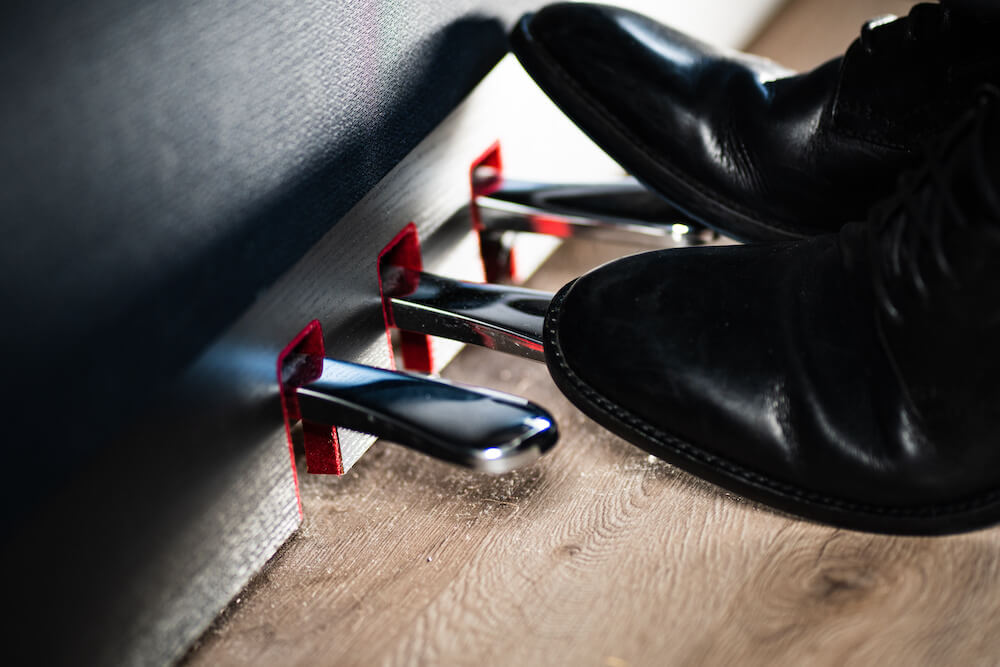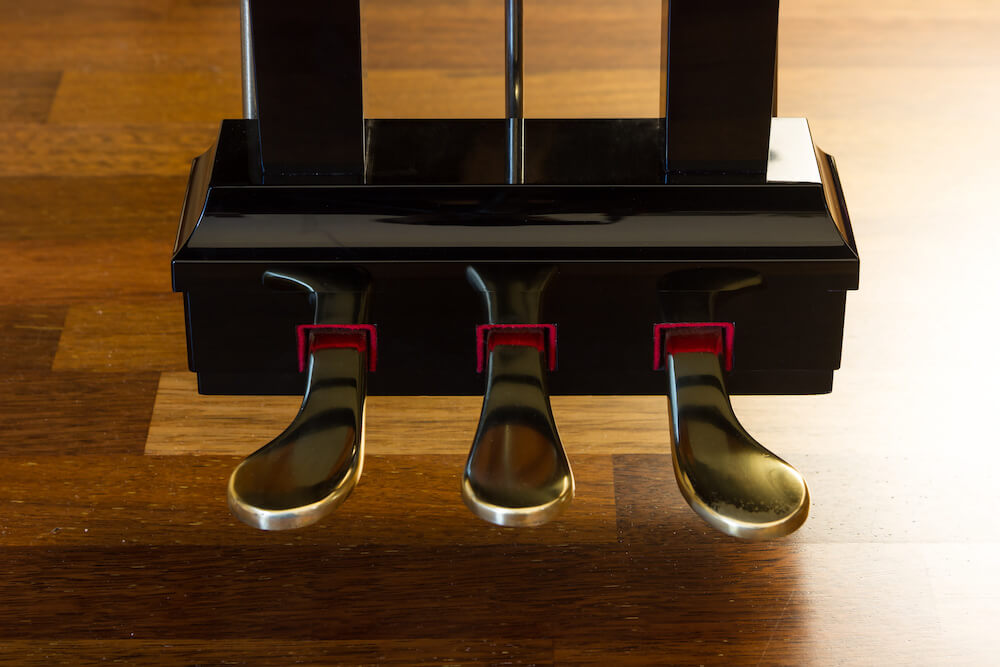When it comes to musical instruments, one of the main differences between the piano and other instruments is that the piano is designed in a way that allows its player to more easily control a wide array of sounds.
One of the most commonly known ways that it accomplishes this is through the use of dynamics. If you want to play something that’s nice and soft, just press lightly on the keys. If you want to play something loud and energetic, press harder on the keys. Pretty straightforward.
But what if I told you that along with lending itself well to easily control dynamics, the piano also has ways to easily control how long a note’s sound lasts? Or that there is a cool way to make some notes sustain while others don’t?
This is all made possible by piano pedals and in this post we’ll cover everything you need to know about them. Let’s dive in!
Overview of piano pedals
When sitting in front of an acoustic piano, you’ll notice that placed just in front of your feet are three levers, or “pedals,” positioned fairly close together. From right to left, you have a sustain pedal, a sostenuto pedal, and a soft pedal. Each pedal has a different effect on the sound of the piano.
Sustain pedal
The sustain pedal, also known as the damper pedal, is located on the far right. This pedal is the most commonly used pedal when playing the piano and is operated with the right foot. When stepping down on the sustain pedal, the dampers inside of the piano get lifted off of the strings, allowing them to vibrate freely.
Thanks to the uninterrupted vibration of the strings, any keys that you play while the pedal is pressed down will produce a sound that will continue to ring out, even after you release the keys — producing a sustained, resonant sound. This creates a sense of connectedness between notes and can make your playing sound more fluid, full, or even dreamy. And to top it off, the sound sustains until you release the pedal, at which point the sound will immediately stop.
Soft pedal
Last but not least, we have the soft pedal. This pedal, also known as the una corda pedal, is located on the far left and is operated with the left foot. This pedal is used to create a softer, more muted sound. When you press the soft pedal, the hammers inside the piano shift slightly, so that they hit fewer strings when you play a note — producing the softer sound. This can be useful when you want to play a passage of music softly, without losing the clarity of the notes.
Sostenuto pedal
The sostenuto pedal is located in the middle of the other two pedals, and is operated with the right foot. This pedal is the least commonly used of the three. It allows specific notes to be sustained while other notes played after releasing the pedal do not sustain.
How to use piano pedals
Using the pedals can take some time to get used to at first, but with a little practice and guidance, it becomes much easier. Here are a few tips to help you get started:
Using the sustain pedal
The sustain pedal is used in almost every piece of music, so it’s essential to learn how to use it effectively. When you press down on the sustain pedal, you should feel a slight resistance before it reaches the bottom. This resistance point is where the dampers are lifted off the strings.
As a general rule, you should press down on this pedal when you’re starting to play the notes of a specific harmony (for example, C major), then “reset”, quickly release the pedal at the end of that harmony and press down on it again, once you begin playing the notes of a new harmony (for example, G major). This reset action helps avoid any bleeding from one harmony to the other, helping to avoid any dissonant sounds.
Using the soft pedal
The soft pedal, unlike the sustain pedal, does not need to be reset as you move from harmony to harmony. Instead, you should press down on this pedal whenever you want to play a passage of music that has a soft sound, and release it whenever you no longer want the music to sound soft.
When using the soft pedal, press it down slowly and smoothly with your left foot. The further down you press, the softer the sound will be. Be careful not to press it down too hard, as it can damage the mechanism inside the piano.
Using the sostenuto pedal
The sostenuto pedal is the most complex pedal to use as it’s designed to sustain certain notes and not others. To use this pedal, play and hold down a note or a chord, then press the sostenuto pedal. After releasing the keys, those notes will continue to sound until you release the sostenuto pedal.

Benefits of using piano pedals
Using the piano pedals correctly can enhance the sound and character of the instrument, bringing out its full potential. Here are some of the benefits of using the pedals:
Increased Expression: Using the pedals allows the pianist to create a more expressive and dynamic sound. The sustain pedal can help to create a more sustained sound that can add depth and emotion to a piece of music. The soft pedal can be used to create a more delicate and intimate sound, while the sostenuto pedal can be used to sustain specific notes for a longer duration.
Enhanced Tone: The use of the pedals can enhance the tone of the piano, creating a richer and more resonant sound. The sustain pedal, in particular, can help to create a fuller and more robust sound that can be used to add depth and power to a piece of music.
Improved Technique: Using the piano pedals correctly requires a level of technique and control. As such, practicing piano with the pedals can help to improve your overall playing technique and control.
Musical Interpretation: The use of the pedals can be used to add depth and meaning to a piece of music. As such, understanding how to use the pedals effectively can help you to better interpret a piece of music and bring out its full emotional and musical potential.
Keep practicing with piano pedals
In conclusion, piano pedals are an essential part of piano playing, and understanding how to use them correctly can greatly enhance your playing. By using the sustain pedal, sostenuto pedal, and soft pedal effectively, you can create a variety of sounds and moods through your playing.
One of the best ways to practice your piano pedal skills is by playing along with your favorite songs. And nowadays, thanks to resources like the Playground Sessions piano-learning app, loaded with step-by-step lessons for countless songs, practicing pedaling with your favorite songs is easier than ever. Watching song tutorials on YouTube is another great way to find new songs to practice pedals with.
Now that you know the basics of piano pedals, keep practicing your technique and enjoy the beautiful sounds you can create!
